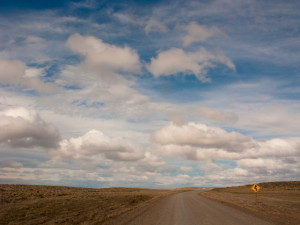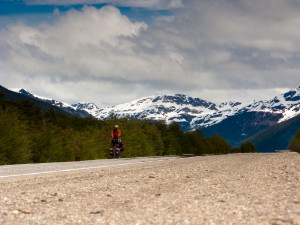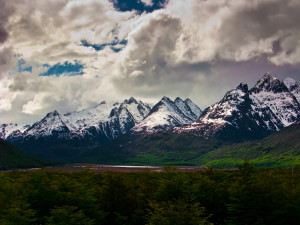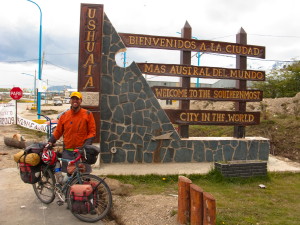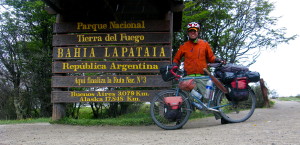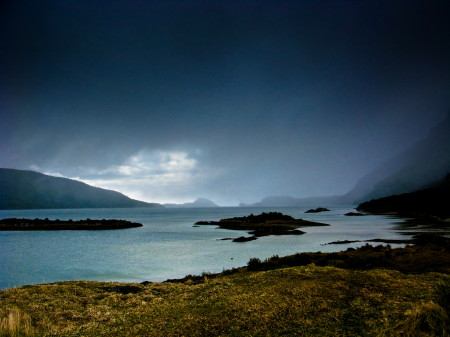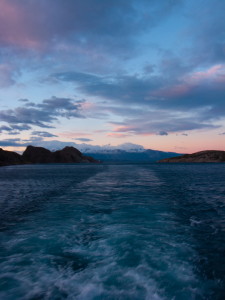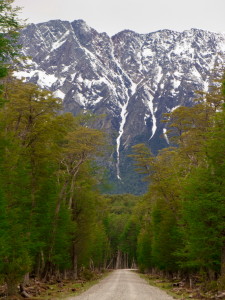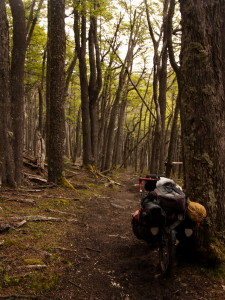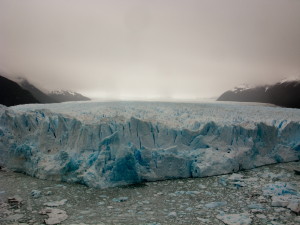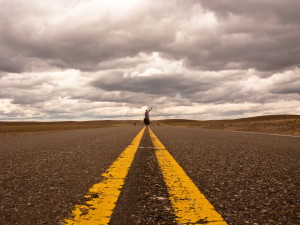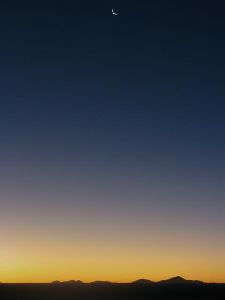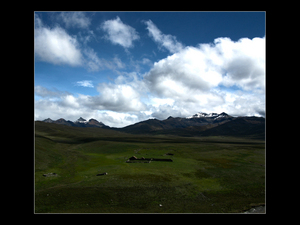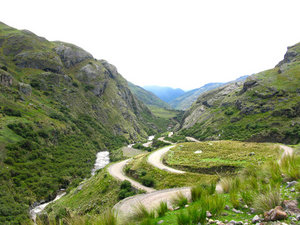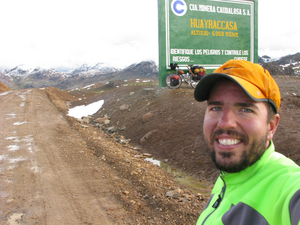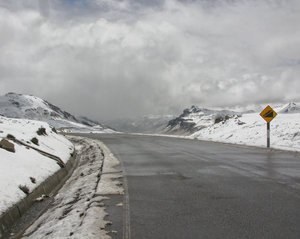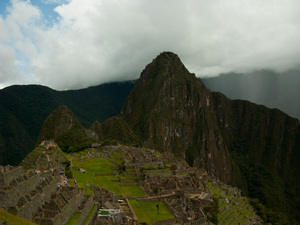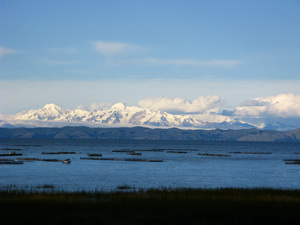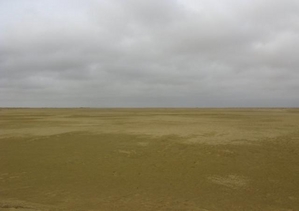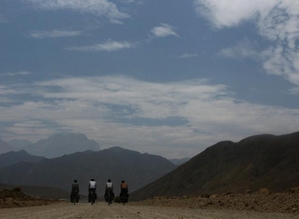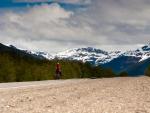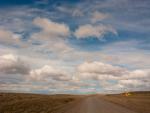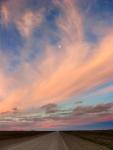A cold chill ran down my neck as the crisp mountain air entered my jacket. I rode around the border gate, they had stamped my passport and not even bothered to leave the warm confines of the station to lift the gate. I marveled at the dirt road; one of the last for a long time I thought, but assumptions are always broken. The first buttery smooth Chilean pavement quickly began rolling under The Trucker as I descended a monstrous decline. I wrapped two scarves around my face in a futile attempt to keep warm, gritted my teeth, and squeezed the handlebars hard in the cold; warm air was waiting in the desert below, I thought. A huge expanse lay before me, Salar de Atacama, the driest desert on Earth. The border station awaited me upon entering San Pedro de Atacama and for the first time of the trip my gear was searched. Twice they attempted to take my machete away, and twice I convinced them otherwise. I promised to stow it while in Chile, being illegal to carry in public, and I did so … until rounding the corner out of sight of the customs office.
Sticker shock quickly had me thinking about getting out of the very touristy San Pedro and back on the road. I planned on taking Paso de Jama to Argentina but asked about Paso de Sico as well at the tourist office. The attendant told me: “You can’t do Sico on a bike this time of year, you would be crazy to try”. That was all I needed to hear. One quick look at some weather satellite images to make sure I wouldn’t get snowed in and I was headed South toward Paso de Sico. The road skimmed the wide valley floor, paralleling a long chain of ominous volcanoes, before beginning a steep climb and the end of the pavement. Horizon after horizon came and went, in a succession that felt as never ending as ocean waves. The road sported a mix of nauseating washboard, loose gravel, and strong freezing headwinds. More volcanoes surrounded me as I cranked past yet more and more salars of varying colors and immense expanses of sand, rock, sand, and rock. I had planned on reaching the only refuge for the next few days, a small mining camp, by the second night, but with the wind and the climbing I made just half the expected distance. I assessed my water situation and found I had drank much more than my days ration, sucking wind in the dry air. I pitched my tent next to the only windbreak in sight, a pile of dirt which provided protection until the wind changed directions in the night and pushed the tent here and there, shivering the night away at -15C / 5F inside the tent. I melted snow from some small patches but found it to be strangely viscous and murky. Surrounded by mineral mountains of such strong and unusual colors, I was cautious of drinking it. I reserved my pasta water for the next day, later lamenting the oil I had added to it.
Shortly after leaving camp, I flagged down the first of three vehicles I would see all day. A group from a mining company was out scouting mine locations in the area were eager to talk to me and load me up with snacks and water. Yet more epic headwinds came to meet me, a constant roar in my ears. I passed yet more salars and lagunas, the bluest lakes I have ever seen. One of which was named “Salar de Aguas Calientes” (hot water / hot spring salar ). I dreamt of taking a dip most of the day until I saw it, no steam rising. It was a lie. Unmatched desolation persisted, and I occasionally rested my weary legs, lying in the ditch for a break from the wind. The only prevalent vegetation, a short, brittle, yellow, grass. I had learned the night before that when pulled, the stalks break into sharp pieces and lodge themselves in the attackers hand. The wind whistled eerily through these plants. In the afternoon, the same miners returned, showering more bottled water, juice, crackers, cookies, avocados, candy, and chocolate on me. Shortly there after I came upon a mining camp, one of the two refuges in this long stretch. A man came out to meet me on the road and explained that I could sleep at the encampment, in a bed, and would be fed. The next day I passed the last refuge on the Chilean side, a small police station; truly in the middle of nowhere. My documents were checked, and I was fed breakfast. I didn’t bother telling them I’d already eaten when they asked if I would was hungry. I watched an apparently important tennis match with them, and answered the many questions they had the any girls I had encountered along the way.
I rolled off toward the pass and Argentina. Vicunas abounded, the softest of the llama-like group of animals. More climbing, more red, yellow mountains, and more baby blue water over salt flats. Eventually the “pass” came into view. The sign in the middle of a huge, windswept, plain indicated I had entered Argentina. One twisty canyon later and even worse roads and I found the border station. Water resupplied, I pedaled onward, flanked on each side by an Andean Fox, escorting me into this new land. Yet more difficult with even worse roads, and worse winds. I have ridden some pretty heinous stretches in the past, but this was by far the worst. Upon reaching the first town, I found no services for money exchange nor anyone able to assist me. I filled my water and continued on towards the next two climbs I would find before finally reaching the downhill that would take me out of the mountains and into Salta.
After picking up some more bike parts and gear in Salta and resting a bit, I headed off to the South; excited to begin the Argentinean wine tour. I passed through the valley of Cafayate, a red rock canyon with more resemblance of the National Parks of Utah than anything you might think you would encounter in Argentina. After dropping down from Paso de Sico , I was now at a lowly 1,152 meters. My red blood cells now of relative gigantic proportion after more than four months around 12,000ft / 3,700m, I enjoyed the thick air that lavished my lungs with decadent oxygen. I passed the days lazily spinning along, still riding for 8 hours or so. The canyon wound with the river around bends and through cactus stands eventually arriving at Cafayate. I spent a few days, staining my insides purple with grape skins before leaving. To the South, the road alternated between long stretches in wide valleys, and more small, sometimes steep, red rock canyons. The winds persisted, but did not bother. Camping was easy, and for the first time I became accostomed to making a fire at night and watching the stars.
I arrived in Mendoza, another wine region, and repeated the same coloring procedure as the North. I stayed a month in this town, killing time to avoid the winter in the route ahead. I took wine tours and enjoyed the local food. Unfortunately, the casinos and many bars were closed due to swine flu scares. One restaurant I entered required each patron to have their temperature taken prior to being seated. A state of emergency had been declared in the region,with a few cases having already been discovered and the worldwide death rate of swine flu at an astounding 0.01% (according to oh so reliable wikipedia.org).
It was a few days ride to re-enter Chile. Upwards to Uspallata, where I ended up walking for more than 10km as the wind had almost succeeded in pushing me off the narrow road several times. I stayed a few days, waiting for the pass to be cleared of recent snowfall. The road gradually climbed up, up, up, until finally I rounded a corner and entered a large, snow covered, valley. I pedaled ahead in the cold wind, and stayed the night at a running ski resort close to the pass. The next day more jaw dropping Andean views laid out before me including Aconcagua, the tallest mountain in the Western Hemisphere and outside of the Himalayas. Unfortunately the road over the top of the pass to the border was closed for the season, more than two meters of snow at the top I was told. So I was driven through a long tunnel and dropped on the other side by the local police, bikes not allowed in the tunnel.
A short distance down and I was stamped out of Argentina and back into Chile. Once again, I was told that my machete was not legal to carry in Chile, and once again I was able to smile and talk my way out of it. I also talked my way out of submitting to the infamous agriculture search, where one cyclist was reportedly fined $1,700.00US for failing to declare some fruit he had and many others lost their spices.
I descended, drawing many looks from bus passengers, disembarking and unloading skis for a day of leisure. One ski lift passed directly over the clear, dry, pavement I rode down; my substrate of fun. I descended the long series of switchbacks and met with warmer air at the bottom. Back to the lowlands, it was only one day to Santiago, through the farmlands and one long tunnel. The highway was littered with large signs stating illegal vehicle types, bicycles included. I reached a tunnel, a large no bicycles sign presented prominently. I searched for another way around or anyone to question in the guard shack, but found neither. Poorly lit, narrow, heavy traffic, and not able to see the other end, I considered my options. Eventually I decided to wait for a lull and take a run at it. It was downhill afterall . I turned on my tail light and sprinted in. I only hoped that no potholes or obstacles were in the way, I could barely see the ground in front of me. Half way through a siren came on, flights flashed above, and something was said over the intercom several times. After traversing this 1.5km or so tube, I received a tongue lashing by the firemen waiting for me on the side . They eventually calmed down and asked why I didn’t have the attendant in the guard station drive me through; there had been no attendant. I apologized profusely and rode off smiling.
I stayed with some friends, also cyclists, who I met in Peru and have since settled for a while in Santiago. They very generously offered their spare room to me, where I lived while catching up on the culinary delights only a big city can offer. I killed more time, waiting for the season to change. A few friends came to visit, and I passed my 30th birthday during the stay. Culturally it seems, for many turning 30 is a wake up call, a “what am I doing” or “what did I do” with my life moment, a seed for a midlife crisis, or a checkpoint to regret the past. I looked back, chuckled at where I was and what I was doing, and smiled. Eventually after bidding farewell to the oh so generous Kirsten and Seth, I rolled out. The road had been calling for some time and the compulsion to pedal was too strong to ignore.
The winds came to meet me, approaching head on. The scenery a bit dull, more farmlands, the Andes only a silhouette in the distance. Finally, the vegetation changed, pine trees became abundant, and lakes appeared as I entered Parque Nacional Villarrica. The landscapes reminded me of the cascades, a reminder that I would soon near the end of the road in the South. I climbed over a small pass, probably the last of it’s size I would encounter, a mere 1,500 meters or so. I camped a short distance from the border, among the strange bamboo like underbrush the clogs any space that it can. The next morning, I rolled through the morning fog, the forest eerie and silent, moss hanging from every branch and snow covered peaks hiding among the clouds. Monkey Puzzle Trees exchanged for Pines under the watchful eye of the emmense and pointy Vocan Lanin. After an uneventful border crossing, I bombed down the road, hoping for a tail wind on the buttery smooth pavement, but none came. Two days later, I entered San Martin de Los Andes and the first picturesque area of Patagonia. Predominant marketing culture forewarned, I was still aghast. Never before had I seen so many North Face, Mountain Hardware, and Columbia clothing stores. It seems the new traditional clothing of this region is Gore-Tex.
I took a route which wound through the massive lakes of the region, calm and quiet, only the Patagonian birds breaking the silence. I had spent quite a bit of time just getting through some of the terrain since Santiago, and here I remembered something I hope to never forget. I remembered how to relax. I lay there on a log on the shore of Lago Espejo and stared at the water, took a short nap, marveled at sunlight on closed eyes, and re-energized my batteries for the next push. I had enjoyed a fairly dry week of sunny weather, something that would change soon.
As I emerged from the park and back onto pavement, sweet pavement, the wind and rain arrived. It soaked me as I cranked onward, then when I turned north around the bottom of the lake it stung my face as I pushed against it. Patagonia is known for it’s extreme winds and I chuckled at this weather, fore I knew it was just a taste. I spent a couple days in Bariloche, waiting for the newly arrived snow flurries to leave. I heard many say something which I have heard many times over the length of this trip: “For this time of year, it’s strange to see this weather.” I eventually left despite the weather, not able to resist the call of the road more than a few days. I rode through yet more lagunas, snow covered mountains, pouring rain, and chilling wind. On one such cold, clouded, soggy day I encountered one of the most frightening things of my life.
El Toro
I woke up late, futilely hoping the rain would subside for at least a few moments to allow me to pack up without yet more soaking. Eventually, when noon rolled around, I donned my heavy, soggy clothes, and shoved my muddy tent into the stuff-sack. The surely magnificent mountains that surrounded me, were cloaked with clouds, yet the snowline still visible just a short distance up from the lake. Still, these lakes, green as seawater and reminiscent of Puget Sound, were a beautiful sight.
I passed cow after cow along the route, grazing at what plants could be found between melting patches of snow. I have passed livestock while riding with great frequency since leaving the US, and never had any issues. A cold rain fell as I spied a young bull in the middle of the route. Turned slightly to my direction, he blocked my route. His breath was forceful, billowing clouds of steam from his flaring nostrils. Typically cows will get out of the way when I approach, but this brazen bovine stood his ground. Something inside me took hold and my actions seemed to occur without thought. I like to think it was some sort of instinct rooted into my brain by ancestors eons back, but in hindsight, I think it was the characterization of an angry bull from all those Looney Toons cartoons that dictated my response.
I came to a stop, maybe 15 feet away. My eyes widened as he hooved the ground furiously. I was sure of one thing, he had an axe to grind and was all the more pissed off with no opposeable thumbs to hold any grinding apparatus. On the one side, some estimated 700 or so lbs of rippling grade A prime Argentinean beef, sure to make any agricultural inspector’s mouth water. El Toro. On the other, the pitifully outmatched, cold, tired, but road worn and well equipped adventurer with will and steel on his side. Me. I reached for my machete and as I drew, he lept. First the jump, then the best run he could muster in a short distance, from my 10:30. He charged. With just enough time, I whirled the machete overhead like a chopper blade, reached, and came down just behind his head only one moment before impact. With the last planting of his hooves he changed direction and turned his head slightly, stunned by the blow or maybe just shocked I was fighting back. I took the impact in the shoulder rather than directly to the chest and was thrown to the ground, the trucker still under me. I scrambled to my feet as quickly as possible, no time to check for injury I thought, as I looked up to see him circle and square up for another run. I prepared for the charge, machete gripped tightly, standing between the fallen Trucker and the ditch. A suspenseful moment passed, our eyes locked in a dead stare. I decided to take the risk to bend down and pick up a rock, considering that this could be seen as a sign of weakness and trigger the beast’s attack. As he huffed and puffed, I eventually nailed him with a rock to the head, sending him fleeing through the bushes.
I took a moment to check for damage of both the trucker and myself, none whatsoever. I had worried that he may have stepped on my wheel as he careened into me, but I was lucky. I chuckling about the experience and thought that since my blade had stood by me and proved itself beyond the usual tasks of preparing wood for a fire, or carrying dried cow chips at a safe distance for burning, it deserved a name. A name that would strike fear into the oversized, tasty, marbled, hearts of it’s enemy and one fitting of the triumphant victory over a foe many times our size. A name that cows would use to make the little dogies behave and make them quiver in their beds at night. And thus this simple blade, made by some unknown soul in the jungles of Peru, became known as “El Carnicero” (the butcher).
The rest of the day I kept a sharp lookout for more agitated agents of the army of bovine, but no more hostiles were encountered. Still, I’m left with a cautiousness from the experience and now consider if the beasts I encounter are planning on trampling me before I pass. I may never look at a cow the same again.
